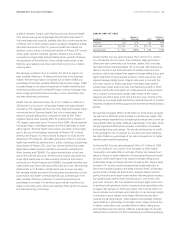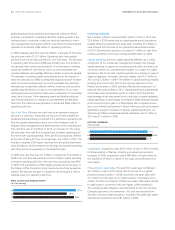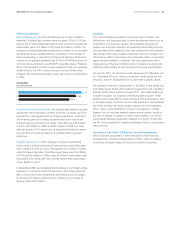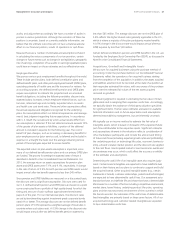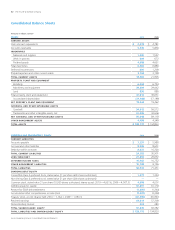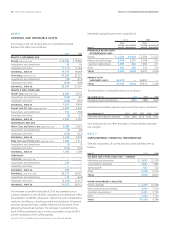Proctor and Gamble 2010 Annual Report Download - page 50
Download and view the complete annual report
Please find page 50 of the 2010 Proctor and Gamble annual report below. You can navigate through the pages in the report by either clicking on the pages listed below, or by using the keyword search tool below to find specific information within the annual report.48 The Procter & Gamble Company Management’s Discussion and Analysis
The costs of determinable-lived intangibles are amortized to expense
over their estimated life. The value of indefinite-lived intangible assets
and residual goodwill is not amortized, but is tested at least annually
for impairment. Our impairment testing for goodwill is performed
separately from our impairment testing of indefinite-lived intangibles.
We test goodwill for impairment by reviewing the book value com-
pared to the fair value at the reportable unit level. We test individual
indefinite-lived intangibles by reviewing the individual book values
compared to the fair value. We determine the fair value of our report-
ing units and indefinite-lived intangible assets based on the income
approach. Under the income approach, we calculate the fair value of
our reporting units based on the present value of estimated future
cash flows. Considerable management judgment is necessary to
evaluate the impact of operating and macroeconomic changes and
to estimate future cash flows to measure fair value. Assumptions used
in our impairment evaluations, such as forecasted growth rates and
cost of capital, are consistent with internal projections and operating
plans. We believe such assumptions and estimates are also comparable
to those that would be used by other marketplace participants. When
certain events or changes in operating conditions occur, indefinite-
lived intangible assets may be reclassified to a determinable life asset
and an additional impairment assessment may be performed. We did
not recognize any material impairment charges for goodwill or intan-
gible assets during the years presented.
Our annual impairment testing for both goodwill and indefinite-lived
intangible assets indicated that all reporting unit and intangible asset
fair values exceeded their respective recorded values. However, future
changes in the judgments, assumptions and estimates that are used
in our impairment testing for goodwill and indefinite-lived intangible
assets, including discount and tax rates or future cash flow projections,
could result in significantly different estimates of the fair values. A
significant reduction in the estimated fair values could result in impair-
ment charges that could materially affect the financial statements in
any given year. The recorded value of goodwill and intangible assets
from recently acquired businesses are derived from more recent
business operating plans and macroeconomic environmental conditions
and therefore are more susceptible to an adverse change that could
require an impairment charge.
For example, because the Gillette intangible and goodwill amounts
represent values as of a relatively more recent acquisition date, such
amounts are more susceptible to an impairment risk if business
operating results or macroeconomic conditions deteriorate. Gillette
indefinite-lived intangible assets represent approximately 89% of the
$26.5billion of indefinite-lived intangible assets at June30, 2010.
Goodwill allocated to stand-alone reporting units consisting primarily
of businesses purchased as part of the Gillette acquisition represents
42% of the $54.0billion of goodwill at June30, 2010. This includes
the Male Grooming and Appliance businesses, which are components
of the Grooming segment, and the Batteries business, which is part
of the Fabric Care and Home Care segment.
With the exception of our Appliances and Salon Professional businesses,
all of our other reporting units have fair values that significantly exceed
recorded values. As noted above, the Appliances business was acquired
as part of the Gillette acquisition and is a stand-alone goodwill
reporting unit. The Salon Professional business consists primarily of
operations acquired in the Wella acquisition and is part of the Beauty
segment. As a result of the organization changes to the structure of
the Beauty GBU effected on July1, 2009 (see the Recent Business
Developments section and Note11 to our Consolidated Financial
Statements), the Salon Professional business recently became a new
stand-alone goodwill reporting unit. These businesses represent some
of our more discretionary consumer spending categories. The Appliances
business has goodwill of $1.5billion, while the Salon Professional
business has a goodwill balance of $809million. The estimated fair
values of our Appliances and Salon Professional businesses exceed
their carrying values by 18% and 20%, respectively. Because these
businesses are more discretionary in nature, their operations and
underlying fair values were disproportionately impacted by the eco-
nomic downturn that began in fiscal 2009, which led to a reduction
in home and personal grooming appliance purchases and in visits to
hair salons. Our valuation of the Appliances and Salon Professional
businesses has them returning to sales and earnings growth rates
consistent with our long-term business plans. Failure to achieve these
business plans or a further deterioration of the macroeconomic
conditions could result in a valuation that would trigger an impairment
of the goodwill and intangible assets of these businesses.
New Accounting Pronouncements
There were no new accounting pronouncements issued or effective
during the fiscal year which have had or are expected to have a
material impact on the Consolidated Financial Statements. For a
discussion of new accounting pronouncements, see Note1 to our
Consolidated Financial Statements.
OTHER INFORMATION
Hedging and Derivative Financial Instruments
As a multinational company with diverse product offerings, we are
exposed to market risks, such as changes in interest rates, currency
exchange rates and commodity prices. We evaluate exposures on a
centralized basis to take advantage of natural exposure netting and
correlation. Except within financing operations, we leverage the
Company’s broadly diversified portfolio of exposures as a natural hedge
and prioritize operational hedging activities over financial market
instruments. To the extent we choose to further manage volatility
associated with the net exposures, we enter into various financial
transactions which we account for using the applicable accounting
guidance for derivative instruments and hedging activities. These
financial transactions are governed by our policies covering acceptable
counterparty exposure, instrument types and other hedging practices.
Note5 to the Consolidated Financial Statements includes a detailed
discussion of our accounting policies for financial instruments.





